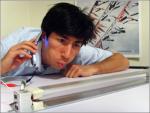Could Wind Power Work In Haiti?
 The Haiti Support Group sent in an interesting article about the Windbelt, an innovative wind harvesting technology. The device was invented by Shawn Frayne who was inspired while working in Haiti's Petit Anse. Miniature versions are used for powering small devices while larger models could potentially be used as a community energy source in rural areas. You can learn more by visiting the Humdinger website and its frequently asked question section. Inquiries can be directed to wind@humdingerwind.com
The Haiti Support Group sent in an interesting article about the Windbelt, an innovative wind harvesting technology. The device was invented by Shawn Frayne who was inspired while working in Haiti's Petit Anse. Miniature versions are used for powering small devices while larger models could potentially be used as a community energy source in rural areas. You can learn more by visiting the Humdinger website and its frequently asked question section. Inquiries can be directed to wind@humdingerwind.com
Humdinger's Wind-Power Alternative
Business Week
As an MIT engineering undergraduate visiting the rural fishing village of Petite Anse, Haiti, in 2004, Shawn Frayne hoped to devise a way to convert abundant agricultural waste into cheap fuel. But the budding engineer soon found that the community's mainly poor residents faced an altogether more immediate need. Unconnected to the local power grid, they relied heavily on dirty kerosene lamps, which are not only costly to operate but also unhealthy and dangerous. He decided to devise an alternative—a small, safe, and renewable power generator that could be used to power LED lights and small household electronics, such as radios. The result is the Windbelt, a miniaturized wind-harvesting power generator that has absolutely nothing in common with the traditional, towering wind turbines that dot the fields a nd shorelines of developed countries.
The simple device was awarded $10,000 in late September as a finalist for the Curry Stone Design Award, a charitable prize that aims to boost design and innovation projects for developing countries. Frayne, now 27, also won a Popular Mechanics Breakthrough Award last fall, earning him a coveted spot on that magazine's annual list of up-and-coming scientists and engineers. Now Frayne and his five-man startup, Humdinger Wind Energy in Honolulu, Hawaii, are working on turning a promising prototype into reality.
"Wind power has pretty much looked the same for the past 80 years," says Frayne over the crackle of a Skype phone call from Xela, Guatemala, where Humdinger is working in rural locations to develop production-ready versions of the Windbelt. After his initial prototypes proved too expensive or inefficient (or both), Frayne took a different tack, eschewing a propeller-type design for an entirely different idea. About the size of a cell phone, the final Windbelt prototype employs a taut membrane that, when air passes over it, vibrates between metal coils to generate electricity. Frayne claims it is the first wind device of any size not to employ turbines.
Indeed, the roots of his innovation are unexpected: Frayne says he was inspired by studying the Tacoma Narrows Bridge in Washington State, which dramatically collapsed in 1940 due to powerful vibrations caused by the wind. The Windbelt harnesses those same dynamics to generate power. Adaptable to Developed Economies, Frayne's device joins a growing array of simple, inexpensive technologies created for developing countries that have also garnered considerable attention in the U.S. and Europe. "Innovations arising from problems in developing economies should meet the challenges of developed economies, too," says Frayne emphatically.
With that in mind, Humdinger is taking "a market-oriented approach," he says. That means pitching Windbelt technology as a green way to power air-quality sensors or WiFi transmitters in new buildings in the developed world, for instance. "People are realizing that smartly designed micro-installations can have a big impact," says James Brew, a principal architect with the Rocky Mountain Institute, a green think tank in Aspen, Colo. The Windbelt's small size and negligible cost, adds Brew, make it potentially applicable in developed settings—such as new skyscrapers—as well as the more rugged conditions of the world's rural villages. Though he won't reveal how much funding the group has received to date, Frayne says it would cost upwards of $30 million in venture capital to expand the company so it could manufacture Windbelts itself. More likely, Humdinger will end up licensing the technology to other manufacturers, which would assume development costs.
Undeterred by the obvious challenges of marketing an entirely new type of wind power generator, and even though wide distribution is still some years off, Humdinger is forging ahead. In the past year, the group has established pilot programs in Guatemala and Haiti as well as rapid-prototyping facilities in Hong Kong. They are also working on larger versions that could generate significantly more power. The Windbelt may have started with personal curiosity, but Frayne's mission has changed dramatically. "We're really trying to develop the new building blocks of wind energy," he says.
Vella is a writer for BusinessWeek.com in New York.
Add new comment